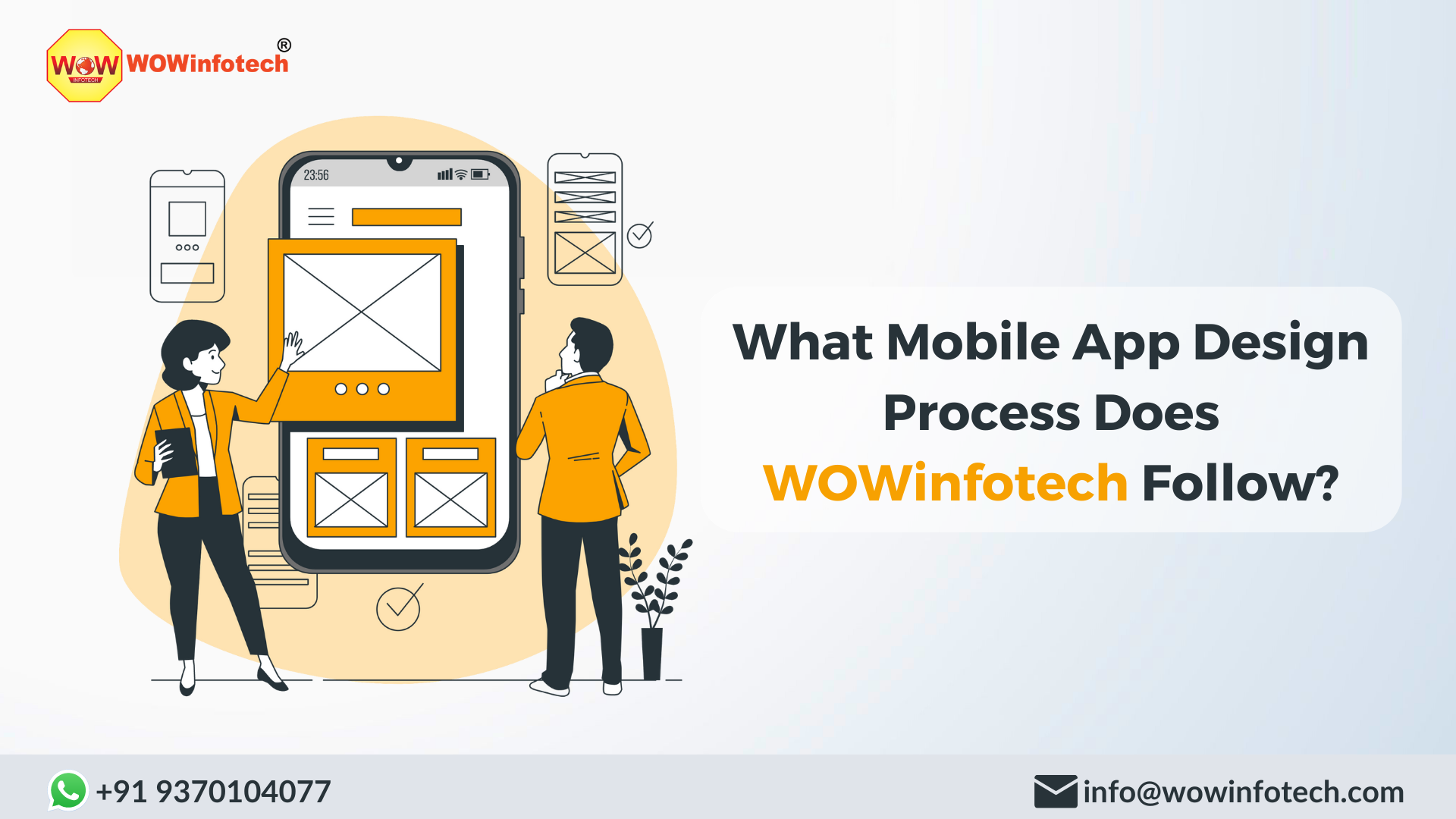The process of mobile app design is a critical part of the app development process. A well-designed app not only provides a great user experience but also makes it easier for users to understand the app's functionality. A poorly designed app can make it difficult for users to understand the app's purpose, which can lead to a high number of uninstalls. As a result, it is important to approach the design of a mobile app with care and attention to detail.
The mobile app design has become an essential aspect of businesses in India, with a rapidly growing number of smartphone users. In today's digital age, having a well-designed and user-friendly mobile app can significantly impact the success of a business. With a team of experienced designers, we at WOWinfotech offer top-notch mobile app design services in India.
Our design process starts by understanding our client's requirements, goals, and target audience. Our team of experts then works to create an intuitive and visually appealing design that aligns with the brand's image and resonates with the users. We believe that the design should not only look good but also provide a seamless user experience.
We have extensive experience in designing mobile apps for various industries, including e-commerce, finance, healthcare, and more. Our designers stay up-to-date with the latest design trends and technologies to ensure that our clients receive the best possible outcome.
Step 1: Understanding User Needs and Goals
The first step in the mobile app design process is to understand the needs and goals of the app's target audience. This includes identifying the target audience's age, gender, education level, interests, and more. This information is used to develop a user persona, which is a fictional representation of the app's target audience. The user persona helps designers understand the target audience's needs and goals and provides a basis for the design of the app.
Step 2: Conducting Market Research
Market research is an important step in the mobile app design process. This involves researching similar apps in the market, analyzing their design, and identifying what makes them successful. The research should also identify any gaps in the market that the app can fill. This information is used to inform the design of the app and ensure that it stands out from similar apps in the market.
Step 3: Creating a Conceptual Design
Once the research has been conducted, the next step is to create a conceptual design. This involves creating a rough sketch of the app's interface, including the app's layout, navigation, and overall look and feel. The conceptual design should also take into account the app's functionality and the user's goals. This stage is important because it allows designers to test their ideas and make changes before the app is developed.
Step 4: Wireframing
Wireframing is the process of creating a detailed, functional design of the app. This includes creating a visual representation of each screen in the app, including the navigation, buttons, and text. The wireframe should be detailed enough to give a clear understanding of the app's functionality but not so detailed that it becomes difficult to make changes.
Step 5: Designing the User Interface
Once the wireframe has been created, the next step is to design the user interface (UI). This involves creating a visual design that is aesthetically pleasing and easy to use. The UI should be consistent throughout the app, using the same color scheme, font, and button styles. It should also take into account the user persona, providing an interface that is easy to understand and use.
Step 6: Prototyping
Prototyping is the process of creating a functional model of the app. This allows designers to test the app and make changes before it is developed. The prototype should be as close to the final product as possible, including the same layout, navigation, and functionality. This stage is important because it allows designers to identify any problems with the app's design and make changes before the app is developed.
Step 7: Testing and Iteration
Once the prototype has been created, the next step is to test the app. This involves testing the app on different devices, including smartphones and tablets, and identifying any problems. The testing should also include user testing, where users are asked to use the app and provide feedback. The feedback should be used to make changes to the app's design, including fixing any problems and improving the user experience.
Step 8: Development
Once the design has been finalized, the next step is to develop the app. This involves programming the app's functionality, including navigation, buttons, and text. The development stage is critical because it is when the app's functionality is implemented, and any problems that were identified in the testing stage can be fixed. The development stage should also take into account any changes that were made during the testing and iteration stage. The developer should work closely with the designer to ensure that the app's design is accurately reflected in the final product.
Step 9: Quality Assurance
Quality assurance (QA) is an important part of the mobile app development process. This involves testing the app thoroughly to identify any bugs or problems. The QA stage is critical because it ensures that the app is of high quality and ready for release. The QA stage should be comprehensive, testing the app on different devices, including smartphones and tablets, and identifying any problems. The app should also be tested under different conditions, including low battery and low signal strength.
Step 10: Launch and Maintenance
Once the app has been developed and tested, the final step is to launch the app. This involves submitting the app to the app store, where it will be reviewed and approved for release. The launch stage is critical because it is when the app becomes available to the public. The launch should be well-planned and executed, with a marketing strategy in place to ensure that the app reaches its target audience.
Once the app has been launched, the final step is to maintain the app. This involves fixing any bugs that are identified and updating the app to ensure that it remains relevant and up-to-date. The maintenance stage is critical because it ensures that the app continues to provide a great user experience, which will keep users engaged and encourage them to continue using the app.
Conclusion:
The mobile app design process is a critical part of the app development process. A well-designed app provides a great user experience and is more likely to be successful. The design process should be approached with care and attention to detail, taking into account the needs and goals of the app's target audience, conducting market research, and creating a conceptual design. The design should be tested and iterated, with changes made to improve the user experience. The app should then be developed and thoroughly tested, with a launch and maintenance plan in place to ensure its success.
If you're looking for a reliable and experienced mobile app design company in India, look no further. Contact us today to schedule a consultation and learn how we can help bring your mobile app idea to life.
#Design #MobileApp #MobileAppDesign #AppDesign #MobileAppDesignProcess #AppDesignCompany #AppDesigner #AppDevelopment
-

Krishna Handge
WOWinfotech
Jul 01,2023
